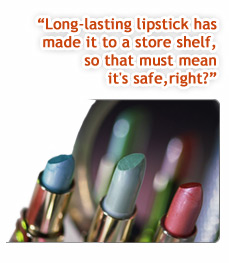  That brand-new shampoo or long-lasting lipstick has made it to a store shelf, so that must mean it's safe, right?
Not necessarily.
Without a thought, most of us sail through our morning routines, showering, styling, and shaving. We lengthen our lashes and powder the baby, secure in our belief that everything we put on our skin has earned some controlling authority's seal of approval.
In fact, by the time the average women has the first sip of her morning coffee, she's lathered, rinsed, and repeated herself into exposure to approximately 126 toxic ingredients.
It's enough to make you drop your latte and ask, "Why isn't the government doing anything about this?"
Answer: They don't have to. The Food and Drug Administration (FDA) merely requires that manufacturers ensure that personal care products are "safe for their intended use." And as far as manufacturers are concerned, "safety" has only been specifically defined as a product that won't irritate your skin. Cosmetic companies will sound the alarms faster if one of their products gives someone a nasty rash than if it puts them at risk for being infertile.
Ask most cosmetic manufacturers, and they will say that any questionable chemicals used in their products are "at safe levels," and studies that claim otherwise are inconclusive. While this may be true, our lifelong personal toxic bank account is what concerns consumer advocates like Stacy Malkan, of the Campaign for Safe Cosmetics.
"We're repeatedly rubbing these toxic chemicals on our bodies day after day, year after year, with a huge number of products," Malkan says. "The government risk assessments consider only one product at a time, one toxic chemical at a time, so they vastly underestimate risk."
 Considering that our bodies also harbor a staggering load of chemicals from our environment, such as pesticides, heavy metals, food additives, and factory and vehicle emissions, this risk can grow exponentially. In a study of a small group of people from across the United States, each subject tested positive for an average of 90 different chemicals.
Most of these chemicals "didn't even exist when my parents were young," says Alan Greene, MD, FAAP, a prominent, award-winning pediatrician and clinical professor of pediatrics at Stanford University School of Medicine. "We know that when two chemicals are present, their effects are often multiplied rather than added. Scientists have documented that when non-toxic levels of PCBs [polychlorinated biphenyls] are mixed with low levels of dioxin [used mainly to bleach paper products] the combination produces 400 times the damage of dioxin alone. What might the effects of 90 different chemicals be, even at low levels?"
We have a general idea, especially in children, who because of their small size and developing bodies are more vulnerable to toxic exposure.
"We know that, at high enough levels, pesticides and other chemicals (such as mercury) found in food cause a variety of significant health problems in children, including cancer, attention deficit disorder, learning disabilities, genital abnormalities, and reproductive problems," says Dr. Greene. "We know that the very problems caused by environmental chemicals are increasing in our society and in our children."
And asking our bodies -- especially young bodies -- to also absorb the toxins in our personal care products might be adding fuel to the fire.
The worst ingredients in cosmeticsThe following list of chemicals found in many cosmetic products, while not complete, may contribute to the toxic load in the average American's body.
Phthalates. These chemicals (pronounced "thalates") make plastics more flexible and the synthetic fragrance in your silky body cream last longer. They can be found in lipstick, hairspray, and many other products.
Phthalates are the chameleons of the personal care products industry, disappearing into a bottle and reappearing on the ingredients list as something merely called "fragrance." Hiding behind that innocuous-sounding ingredient could be a boatload of chemicals that have been found in the blood and urine of people (including infants). Phthalates are also in the environment, from the dust on your coffee table to your drinking water.
Parabens. This family of synthetic preservatives used in some antiperspirants and deodorants includes methylparaben and propylparaben, among others. Parabens have been found in breast tumors. So far, however, studies are conflicting about what, if any, role parabens may play in breast cancer.
Mercury. Thimerosal, a form of the toxic heavy metal mercury used as a preservative, is still found in some mascaras and other cosmetics. This is the same preservative being eliminated from vaccines.
Lead. Lead is a known neurotoxin, and, since it's a contaminant, it won't appear on a products' list of ingredients. The FDA is investigating recent claims that many brand-name lipsticks contain lead.
Protecting yourself and your family- Keep it simple. Try to use natural alternative cosmetic products when possible. They are often found in your local health food store or food co-op. Look for products with a short list of ingredients that don't require a chemistry degree to pronounce.
- Don't be misled by products that claim to be "safe" or "natural." A product with packaging or a name that leads you to believe it sprung right from a garden may contain that elusive word "fragrance" (phthalates) on its list of ingredients.
- Check the safety of the ingredients in your personal care products at the National Library of Medicine's Household Products Database.
Still want to buy that new shampoo? Again, always read labels. Considering what may already be in your body, you could be getting more for your money than shiny clean hair.
|